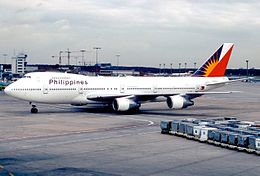This article needs additional citations for verification. (June 2011) |
 EI-BWF, the aircraft involved in the incident taxiing at Zurich Kloten International Airport in December 1988. | |
| Bombing | |
|---|---|
| Date | December 11, 1994 |
| Summary | Bomb planted by Ramzi Yousef as a test for the Bojinka plot |
| Site | Minami Daito Island, Okinawa, Japan 25°50′45″N 131°14′30″E / 25.84583°N 131.24167°E |
| Aircraft | |
| Aircraft type | Boeing 747-283BM Combi |
| Operator | Philippine Airlines |
| Registration | EI-BWF |
| Flight origin | Ninoy Aquino International Airport, Pasay, Philippines |
| Stopover | Mactan–Cebu International Airport, Cebu, Philippines |
| Destination | Narita International Airport, Tokyo, Japan |
| Occupants | 293 |
| Passengers | 273 |
| Crew | 20 |
| Fatalities | 1 |
| Injuries | 10 |
| Survivors | 292 |
Philippine Airlines Flight 434, sometimes referred to as PAL434 or PR434, was a scheduled flight on December 11, 1994, from Manila to Tokyo with a quick stopover in Cebu on a Boeing 747-283B that was seriously damaged by a bomb, killing one passenger and damaging vital control systems, although the plane was in a repairable state.[1] The bombing was a test run of the unsuccessful Bojinka terrorist attacks. The Boeing 747 was flying the second leg of a route from Mactan–Cebu International Airport in Cebu, Philippines to Narita International Airport, in Tokyo, Japan. After the bomb detonated, 58-year-old veteran pilot Captain Eduardo "Ed" Reyes was able to land the aircraft, saving it and the remaining passengers and crew.[2]
Authorities later discovered that Ramzi Yousef, a passenger on the aircraft's prior flight leg from Manila's Ninoy Aquino International Airport, had placed the explosive.[3][4] Yousef boarded the flight under the fake Italian name "Armaldo Forlani", an incorrect spelling of the name of the Italian legislator[5] Arnaldo Forlani, in order not to get caught.[6] Yousef was later convicted of the 1993 World Trade Center bombing.[4]
- ^ Caña, Paul John (December 11, 2020). "Remembering the Bombing of PAL Flight 434". Esquiremag.ph. Retrieved 2021-05-24.
- ^ "TRIBUTE TO CAPTAIN EDUARDO REYES". Congressional Record (Bound Edition), Volume 153 (2007), Part 3. Retrieved August 7, 2020.
- ^ State's Security Bureau Takes on Expanded Role, Washington Post, September 27, 2004.
- ^ a b CNN.com, January 8, 1998. 'Proud terrorist' gets life for Trade Center Bombing.
- ^ Yousef bombs Philippines Airlines Flight 434, GlobalSecurity.Org report on incident
- ^ "Bomb on Board". Mayday. Season 3. Episode 5. 12 October 2005. Discovery Channel Canada / National Geographic Channel.